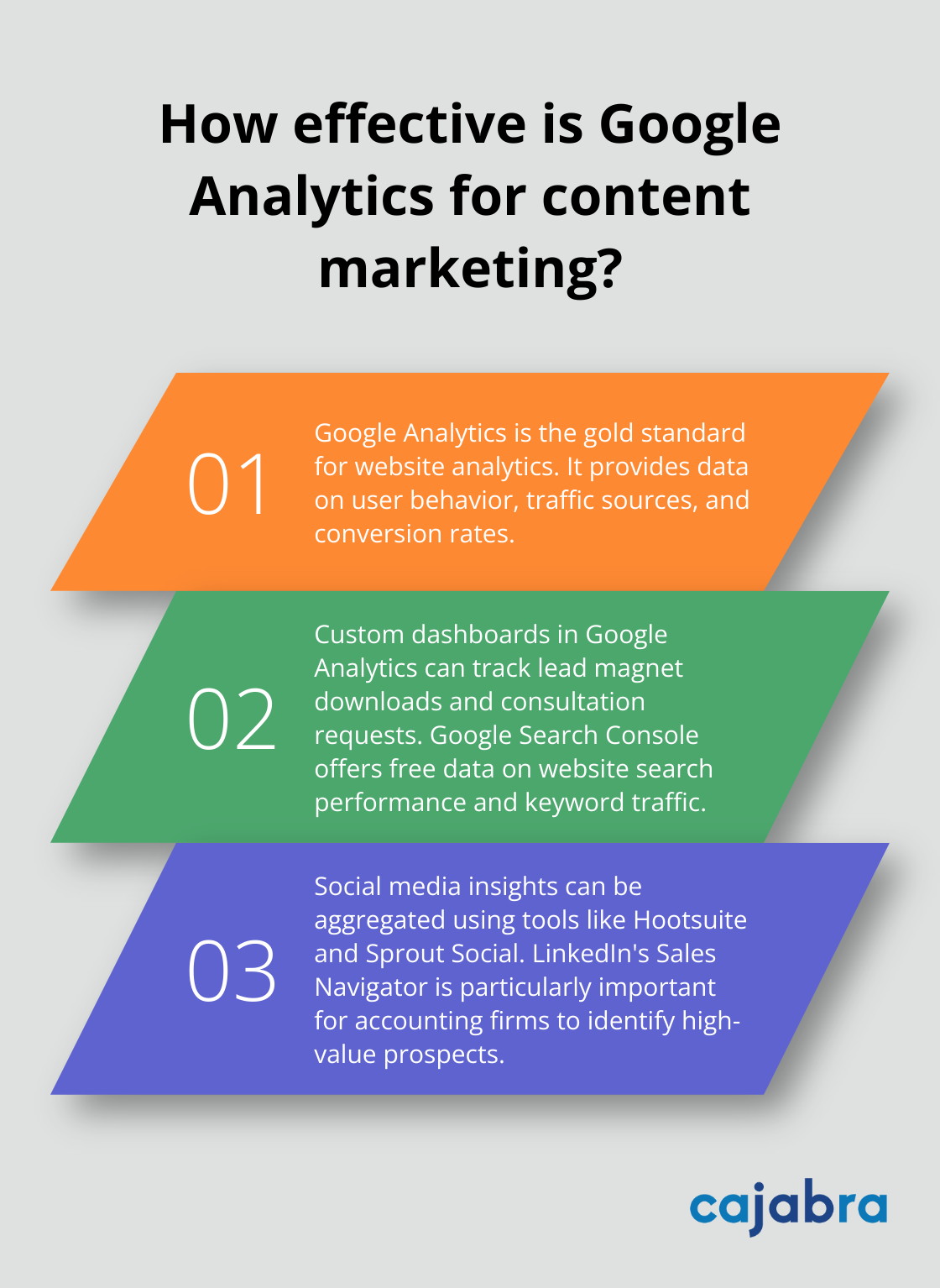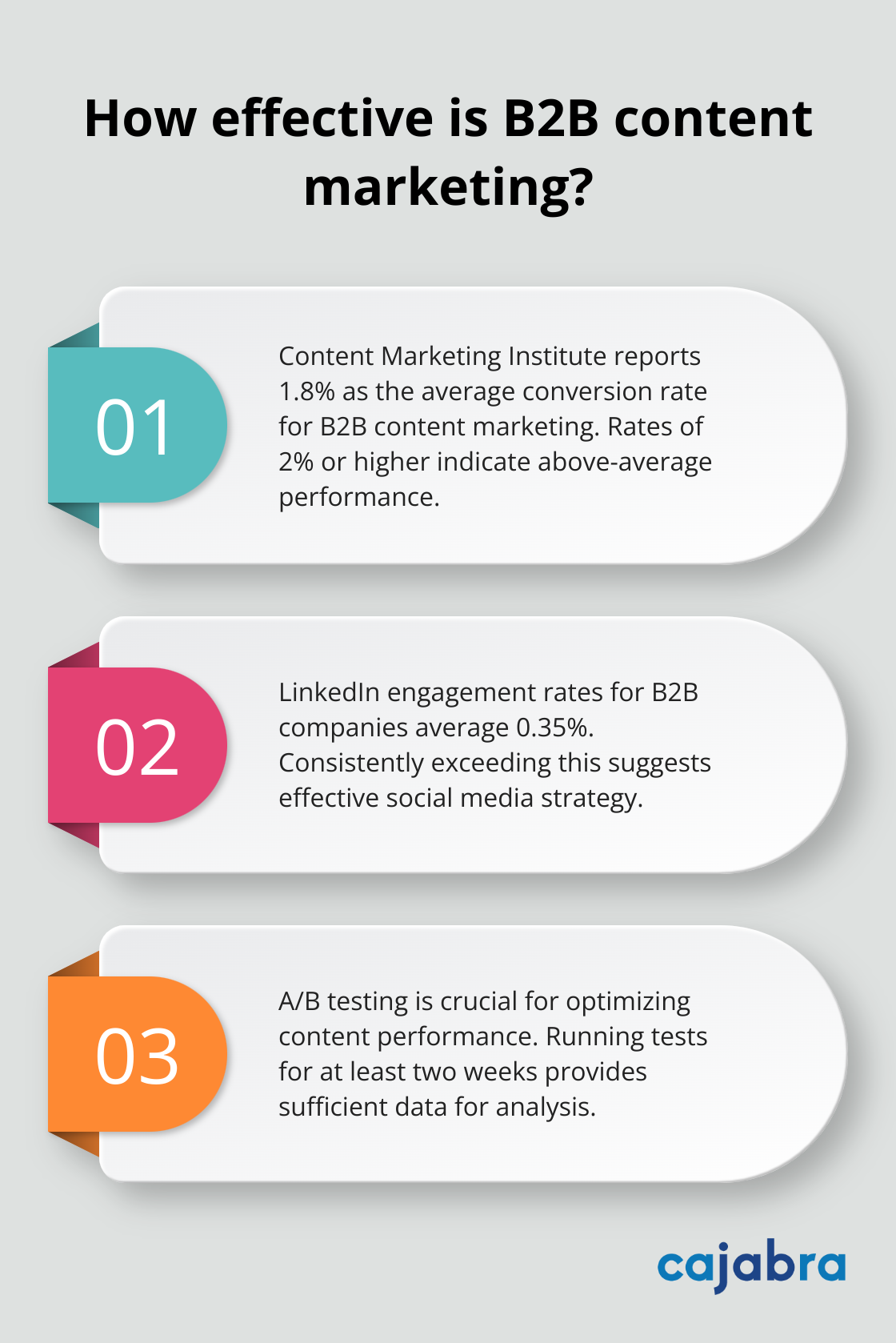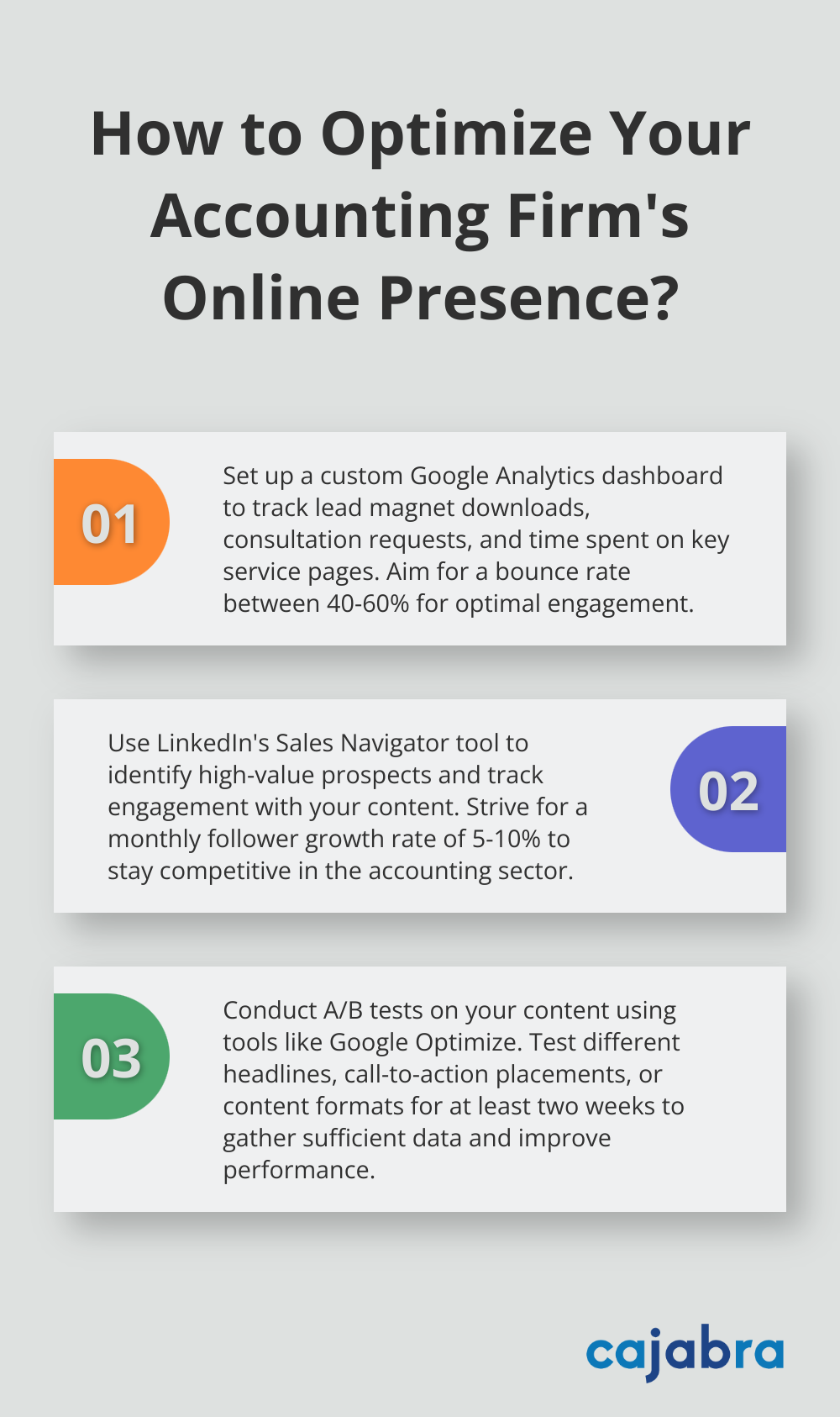
Content marketing metrics are the compass guiding your strategy's success. Without them, you're navigating blindfolded through a competitive digital landscape.
At Cajabra, LLC, we've seen firsthand how measuring content performance can transform marketing efforts. This post will equip you with the tools and techniques to effectively gauge your content's impact and drive real results.
Content marketing success depends on tracking the right metrics. We have identified key performance indicators (KPIs) that truly matter for accounting firms looking to boost their online presence and client acquisition.
Website traffic is a fundamental metric, but it's not just about quantity. Quality traffic that engages with your content is what counts. Google Analytics serves as an excellent tool for tracking page views, unique visitors, and time on page.

Traffic alone doesn't tell the whole story. Bounce rates help gauge content relevance. If your bounce rate exceeds 70%, it's time to reassess your content strategy. Try to achieve a rate between 40-60% for optimal engagement.
Conversions fuel your marketing efforts. For accounting firms, this could mean newsletter sign-ups, whitepaper downloads, or consultation requests. Setting up goal tracking in Google Analytics allows you to monitor these actions effectively.
High-growth accounting firms are investing in marketing at much higher rates than their peers. Many firms have experienced significant increases in lead generation within months of implementing a targeted content strategy.
Social media metrics extend beyond likes and followers. Shares, comments, and click-throughs measure how your content resonates with your audience. LinkedIn proves particularly powerful for accounting firms, with 89% of B2B marketers using it for lead generation.
Audience growth rate also warrants attention. A steady increase in followers indicates your content hits the mark. Try to achieve a monthly growth rate of 5-10% to stay competitive in the accounting sector.
Organic search visibility is essential for long-term success. Tools like SEMrush help track keyword rankings and search engine results page (SERP) positions.
Focus on ranking for industry-specific long-tail keywords. These may have lower search volumes but often indicate higher intent and are easier to rank for. Many accounting firms have increased their organic traffic significantly by targeting niche keywords relevant to their specialties.
These KPIs provide a clear picture of your content marketing performance. The next section will explore the tools and techniques that make measuring success more manageable and insightful.
Content marketing measurement requires a robust toolkit. We've identified the most powerful platforms that provide actionable insights for accounting firms.
Google Analytics remains the gold standard for website analytics. It offers a wealth of data on user behavior, traffic sources, and conversion rates. To maximize its potential, set up custom dashboards tailored to your KPIs. Create a dashboard that tracks lead magnet downloads, consultation requests, and time spent on key service pages.

Many accounting firms overlook the power of Google Search Console. This free tool provides invaluable data on your website's search performance. Use it to identify which keywords drive traffic to specific pages and optimize your content accordingly.
While most social platforms offer native analytics, third-party tools can provide a more comprehensive view. Hootsuite and Sprout Social excel at aggregating data across multiple channels, offering a holistic view of your social media performance.
For accounting firms, LinkedIn's analytics are particularly important. The platform's Sales Navigator tool can help identify high-value prospects and track engagement with your content.
SEMrush and Ahrefs are industry leaders for SEO and content performance analysis. These tools offer keyword research, competitor analysis, and backlink monitoring. They're invaluable for identifying content gaps and opportunities in the accounting sector.
Content-specific tools like BuzzSumo can reveal which topics and content formats resonate most with your audience. Use it to analyze your competitors' most shared content and identify trending topics in the accounting industry.
A robust Customer Relationship Management (CRM) system is essential for tracking how content influences the client journey. HubSpot and Salesforce are popular choices (offering marketing automation features that can attribute leads and conversions to specific content pieces).
Integrating your CRM with your content management system creates a powerful feedback loop. This integration allows you to see which content types are most effective at nurturing leads through the sales funnel.
The next chapter will explore how to interpret and act on the data collected through these tools, turning insights into actionable strategies for content marketing success.
Data analysis transforms an accounting firm's digital presence. We start by identifying patterns in top-performing content. What topics engage your audience most? Which formats drive engagement? Accounting firms often see higher engagement with content that explains complex tax laws or offers financial planning tips.

Use Google Analytics to pinpoint your best-performing pages. Analyze metrics like time on page, bounce rate, and conversion rate. A traffic spike to a particular blog post suggests creating more content on that topic or repurposing it into different formats.
Comparison to industry benchmarks provides context for your metrics. The Content Marketing Institute reports an average conversion rate of 1.8% for B2B content marketing. A rate of 2% or higher puts you ahead of many peers.
For social media, LinkedIn engagement rates for B2B companies average 0.35%. Consistently exceeding this indicates you're on the right track. However, don't settle for average – push to be in the top quartile of your industry.
A/B testing, also referred to as split testing or bucket testing, is the process of comparing two versions of the same web page, email, or other digital asset. Test different headlines, call-to-action placements, or content formats to drive better results. You might compare a long-form guide's performance against a series of shorter blog posts on the same topic.
Focus on one variable at a time when conducting A/B tests. Run each test for at least two weeks to gather sufficient data. Tools like Google Optimize simplify the setup and analysis of these experiments.
Data's true value lies in strategy improvement. If video content consistently outperforms written posts, allocate more resources to video production. Make topics that drive more leads a central part of your content calendar.
Content marketing requires an iterative process. Review your metrics monthly and prepare to pivot your strategy based on the data. This approach ensures your content remains relevant and effective in the ever-changing landscape of accounting and finance.
Content marketing metrics provide a roadmap for continuous improvement in your marketing strategy. We at Cajabra focus on key performance indicators such as website traffic, conversion rates, and search engine rankings to gain valuable insights into content performance. These metrics enable us to make data-driven decisions and refine our approach over time.

The tools and techniques we explored offer a comprehensive view of content marketing efforts. Regular analysis of trends, industry benchmarking, and A/B testing optimize content for maximum impact. This approach ensures that content remains relevant, engaging, and effective in attracting and retaining clients.
Our specialized marketing services for accountants leverage content marketing metrics to help firms stand out in a competitive market. We implement data-driven content strategies to position firms as industry leaders and attract high-value clients. Embrace the power of content marketing metrics to guide your strategy and measure your success.



